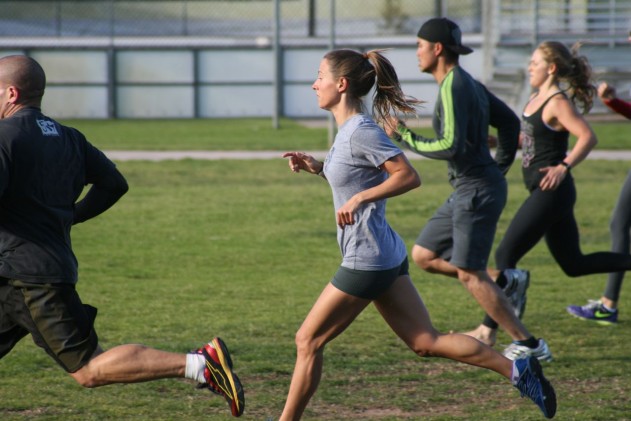It seems strange to think that it takes work in order to rest, and even stranger to realize that resting can initially feel like work. But this is exactly what I discovered over a 10 week period from the beginning of May until the middle of July when I made a decision to only run at a pace slow enough to keep my heart rate in my easy zone.
What I quickly learned was that keeping my heart rate in an easy zone was anything but easy. In fact, it really did feel a whole lot more like work. My easy runs were a struggle, not so much for my body, but for my mind.
The battle really is in the mind
The mind is brilliant, complicated, and often the most frustrating part of our bodies. It’s constantly thinking and processing, and when we really start to pay attention to what’s going on in there, it can be exhausting. When Paul told the Corinthians to “take captive” every thought that didn’t line up with the truth (my paraphrase, see 2 Corinthians 10:5 to read the whole thing), what he was telling them was to get busy doing the hard work of “minding the mind,” as Jennie Allen says it in her book, Get Out of Your Head.
Bear with me for a minute while I do some Greek geeking. The word used for captive only appears 3 other times in the Bible: 2 of them describe taking prisoners and the other describes gaining control.
Translation? It’s going to take work on our part to control our thoughts instead of allowing our thoughts to control us. That’s exactly what I experienced during those 10 weeks of intentionally slower running. My mind hated it.
Because I’ve run multiple marathons and ultra-marathons and numerous shorter races at fairly fast paces, when my heart rate monitor beeped to alert me that I was already out of my easy range, I got frustrated. Because it beeped a lot, I got frustrated a lot. In those times, my thoughts went something like, “What is wrong with you, Paul? You’ve run 50 miles in half a day and you can’t run a quarter of a mile without your heart rate getting too elevated?”
So I’d slow down. Walk. Whatever it took to get my heart back to that elusive easy place. Start running again, trying so hard to keep it under the limit that I’d set, and inevitably, I’d hear the beep again.
“God, you’re a loser!” I’d whisper to myself. “You might as well give up.”
But I didn’t. I fought through 10 of the longest weeks of running I’ve ever experienced and just the other day I typed these words on a running forum I frequent: “I’m starting to see my easy pace drop.”
The payoff is worth it
One of the reasons why I did the whole “only run easy” experiment was because I knew that I was going to head into a marathon training schedule for a fall marathon that I hoped wouldn’t be canceled due to COVID-19. When I found out it was being canceled, I decided to stick with the schedule and run on the days when I was supposed to and do the workouts (easy or hard) that it called for. It was during this time that I made that observation about my easy pace dropping. But that wasn’t the only thing I learned. Here are 2 more takeaways from my running that I think can help all of us (even the non-runners who are reading this) as we do the work of learning to rest.
Rhythms over rules
I know I’ve written a lot about running and so if you’re not into that kind of thing, you’re already hanging on by a thread. Please bear with me a little longer as I explain a typical training schedule so the takeaways will make more sense. A marathon training schedule is usually around 18 weeks long and mine called for 4 runs a week. The schedule tells you when to run and how far or fast to run. Monday might be an easy 3 miles and Wednesday may be a faster pace run of 5 miles. The weekend is always the longest run of the week.
I’m sure you can imagine that there are many times during those 18 weeks that you may not be able to complete the workout. Fatigue, injury, perhaps a global pandemic can all ruin the best plan. So I’ve learned how to embrace rhythms (how often to run) instead of rules (how far or fast to run). I’ve run 4 times a week since I started the plan but I haven’t stressed out on if I ran 5 instead of 7 or an easy instead of a tempo run. My body loves it – there is a rest that I am finding that I didn’t know before. Many followers of Jesus are more upset about broken rules than broken rhythms. But rhythms are inherent in and the lifeblood of relationships.
Many followers of Jesus are more upset about broken rules than broken rhythms. Share on XGuardrails over guilt
When we choose to live by rhythms instead of by rules, something pretty amazing happens: we start to be motivated by guardrails more than guilt. Guilt does weird things to us, doesn’t it? Guilt can make us feel bad for reading 10 minutes in the Bible because a reading plan told us to read for 30 minutes. We see the 20 minutes we didn’t read instead of the 10 we did. Live with guilt long enough and his cousin, legalism, will move in with you, too.
Guilt drives us; guardrails direct us. Share on XGuardrails, though, remind us that if we continue in the way we’re going, we’ll eventually be in trouble. Guardrails allow me to skip a workout and not feel bad about it while holding me accountable to the truth that if I miss weeks of them, I’ll find myself out of shape and in the ditch. Guilt drives us, but guardrails direct us. Guilt leaves no room for rest, but guardrails create room for the occasional bad driver to not become a dead driver.
The work of rest is relearning how to choose rhythms and guardrails over rules and guilt. We live in a rules and guilt culture that values results more than anything. But there is great reward in choosing the alternate path marked by rhythms and guardrails. I’m praying that you find the courage to take it.










